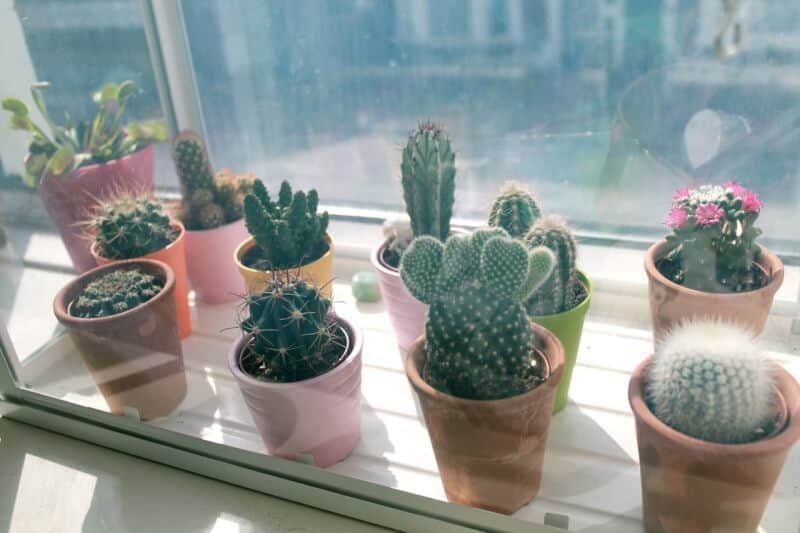Cacti are great plants if you’re just starting gardening. Well, even if you’re an expert at it, a cactus or two is a nice addition to the house. Want to know more about cactus? Read on. Here we will tell you types of cactus, tips for selecting the right cactus, tips for growing and FAQs.
20 Types of Cactus for Your Indoor or Outdoor Garden
Cacti truly are amazing plants. They are easy to take care of can be grown either outdoors or indoors. Below, we listed 20 types of cactus that you can plant outdoors or indoors.
Best Types of Cactus to Plant Indoor
Let’s start with indoor varieties first. Cactus plants are without a doubt a nice addition to any home. Of course, that includes the indoors as well.
If you want to plant a cactus plant or two indoors, consider the following types.
1. Angel Wings

Opuntia microdasys, more popularly known as Angel Wings or Bunny Ears, is a type of cactus native to central and northern Mexico. The shape of the cactus is unique as it resembles a dense shrub.
Angel Wings usually grow to 40 to 60 cm in height. Their stems can grow 6 to 15 cm in length, 4 to 12 cm in width.
Unlike some other types of cactus, Angel Wings doesn’t have any spine. Instead, they have white or yellow glochids grow in clutters.
Another interesting about this type of cactus is that they have individual segments that contain the body of the cactus. The sections of the plant grow in pairs, resulting in a bunny ears-like shape.
Angel Wings is a desert cactus. Meaning, you need to water it regularly when it is planted in a new pot to encourage strong roots. Don’t water the plant during winter.
2. Barrel Cactus
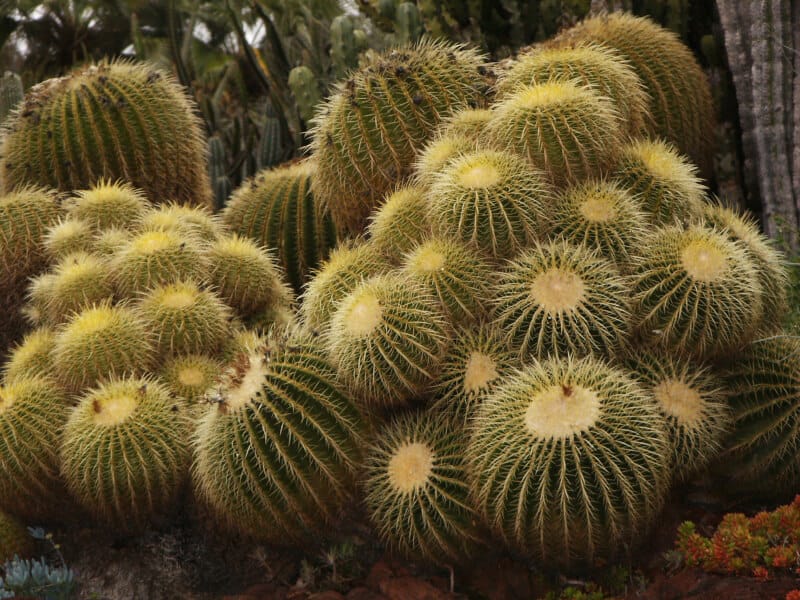
Technically, Barrel cacti consist of various species that belong to Echinocactus and Ferocactus genera. These genera are native to the southwestern part of North America.
Barrel cacti can grow to over 1 meter in height when they reach maturity. Some others can even reach 3 meters in height. In terms of width, they can grow to 30 centimeters.
The average lifespan of Barrel cacti is estimated to be 100 years. In their native habitat, these cacti live in direct sun and extreme heat. So for best growth, you need to mimic this condition as close as possible.
Water requirements of Barrel cacti are low. You can even water them every 2 to 3 months and they will still be alive.
Barrel cacti, unlike other types of cactus, are difficult to check for water due to their shape. So, just water when you think it is necessary in order to avoid root rot. Avoid overwatering.
3. Bishop’s Cap
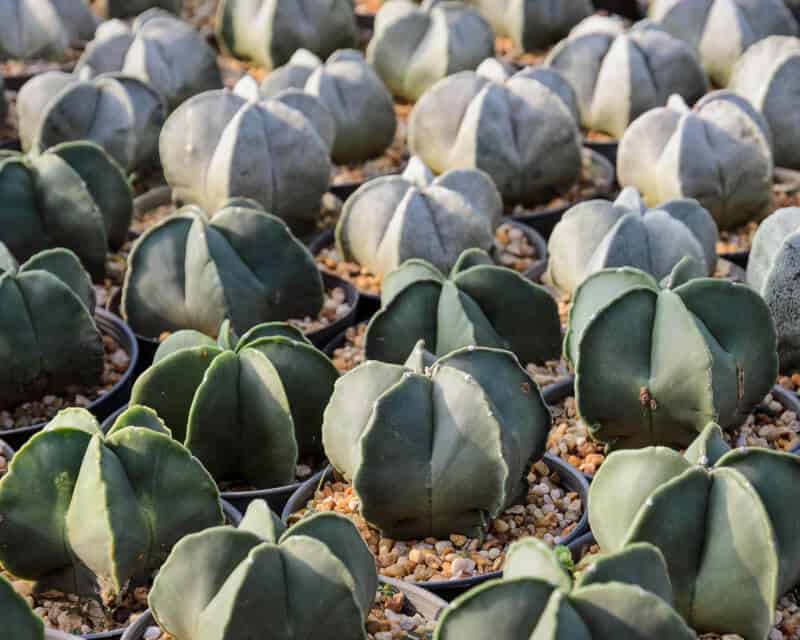
Similar to Angel Wings or Bunny Ears, this cactus’ name describes the plant. Just take a look at the shape. Looks like a cap or hat, isn’t it?
Bishop’s Cap, also known as Bishop’s Hat, is a type of cactus native to central and northeastern Mexico.
Unlike some other types of cactus on the list, the Bishop’s Cap cannot take intense light, especially when they are young. This is why they are better planted indoors than outdoors.
This cactus can grow 70 to 100 cm in height and 10 to 20 cm in diameter. The Bishop’s Cap produces flowers but it may take up to six years to flower.
If you want to plant the Bishop’s Cap, avoid placing the plant under the full sun.
The Bishop’s Cap doesn’t need a lot of water. During summer, water the plant frequently. During winter, avoid watering the plant at all.
4. Christmas Cactus

Why this cactus is named Christmas Cactus? That’s right. Because they bloom around Christmas. So if you’re looking for a plant that can help with your Christmas decoration, this is it.
Christmas Cactus grows beautiful flowers that come in white, pink, yellow, lilac, and red. The flowers generally grow to be 3 inches long.
Christmas Cactus is a type of cactus native to Brazil’s coastal parts. This is why a humid climate is ideal for them.
This type of cactus needs natural light to grow well. That said, direct sunlight should be avoided if you don’t want to encourage the plant from blooming.
Christmas Cactus requires little water. Water the plant every 3 to 4 weeks. Water them only when the pot is dry when you touch it. Do keep in mind that when the plant is flowering, it will require more water.
5. Moon Cactus
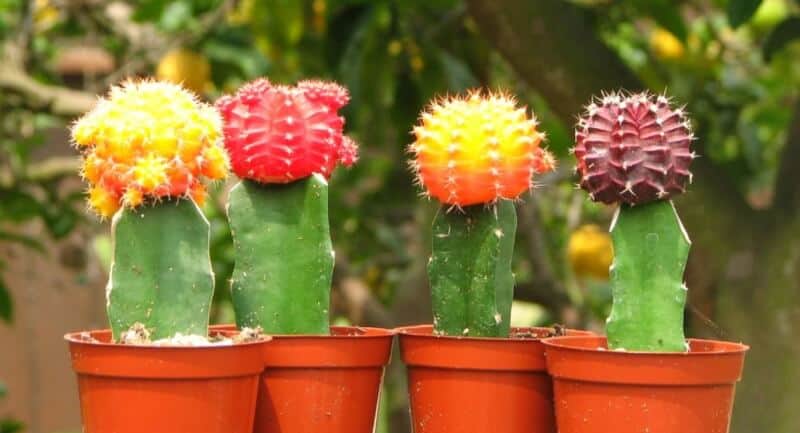
The cactus’ scientific name is Gymnocalycium mihanovichii but it is more popularly known as the moon cactus.
This type of cactus is native to Argentina and Paraguay but they can be found in other parts of South America as well.
What makes the moon cacti stand out is their yellow, orange, pink, or red colors. The parts with these colors are usually ball-shaped.
The moon cactus doesn’t require much water. Water the plant when the soil is dry. During winter, avoid watering the plant unless the plant is young. If the plant is young, water but do so minimally.
This cactus thrives when placed in a bright area. Just don’t place them where sunlight directly hits them.
Because the plant is a low-maintenance cactus, it is a great choice if you’re just starting planting cactus.
6. Old Lady Cactus
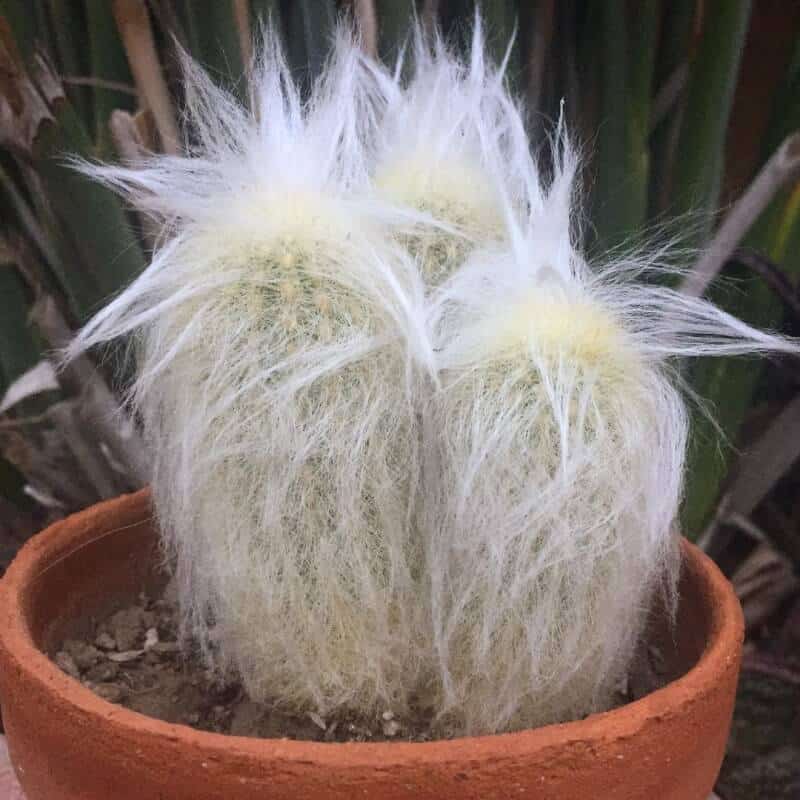
Mammillaria hahniana or Old Lady Cactus is a type of cactus native to central Mexico. This cactus can grow 10 inches by 20 inches (25 cm by 50 cm) broad and 12 cm wide.
Usually, the plant is covered by white spines. The Old Lady can produce purple or red flowers.
Even though the Old Lady cactus is commonly found in arid areas, they make a great indoor plant. Just place them in a sunny place, don’t overwater, and it will grow well.
For optimal growth, choose porous soil for the plant. Choose soil that drains quickly, preventing the roots from sitting in water for too long. Don’t forget to add perlite into the soil.
When it comes to water requirements, the Old Lady doesn’t need much. Water weekly or biweekly when the soil is almost dry.
7. Rat Tail Cactus

Aprocactus flagelliformis, or Rat Tail cactus, is a type of cactus native to Mexico. Although we put this cactus in the indoors list, they can be grown outdoors and in greenhouses as well.
What makes this type of cactus different from other types is that it grows long, trailing stems. The branch can grow 8 to 24 millimeters in thickness and 1 to 2 meters in length.
Rat Tail is a flowering cactus, which grows during spring and summer. The flowers are usually orange, violet, red or pink and can last for several days.
Keep in mind that Rat Tail requires full light to grow optimally. As such, make sure you place them where they can bask in the sunlight.
Rat Tail can grow just fine at room temperature during spring, summer, and early fall. During winter, however, place them in a more relaxed setting.
8. Saguaro Cactus
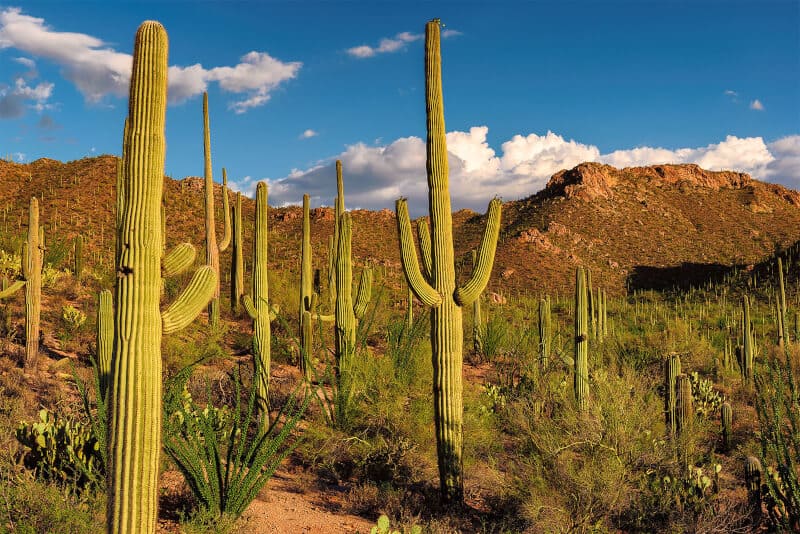
Saguaro cactus, or Carnegia gigantean, is a type of cactus native to the Sonoran Desert. This cactus can grow very tall, to over 40 feet or 12 meters in height. So, why plant it indoors?
Here’s the answer: although Saguaro cactus can grow very tall, they grow very slowly. It takes a decade or so for this type of cactus to reach 1 inch in height.
The lifespan of Saguaro cactus is estimated to be 150 years. Saguaro cactus are barrel-shaped. They can grow peripheral stems, referred to as arms.
After 75 to 100 years, some of the cacti grow their first side arm. Some others don’t grow any arm at all.
Saguaro cactus is a flowering cactus, which they do so in between April and June. The cactus’ flowers open after sunset and then close at mid-afternoon.
Saguaro cacti need to be watered every 10 to 14 days.
Best Types of Cactus to Plant Outdoor
When we mentioned outdoor, we don’t mean dry and boring yards. If anything, cacti add something interesting to any yard. They are great additions, especially if you’re looking for a fresh and unique look.
If you want to plant your cactus outdoors, the following types of cactus are some of your best options.
9. Barbados Gooseberry

Want cacti that produce edible leaves and fruits in your garden? Look no further than the Barbados gooseberry, then.
Scientifically referred to as Pereskia aculeate, Barbados gooseberry is a type of cactus native to tropical America. The cactus produces edible leaves and fruits, which contain protein and iron, among other nutrients.
Edible leaves and fruits are not the only unique things this cactus has. It also has a vine, unlike other types of cactus. The vine of Barbados gooseberry can grow up to 10 meters or 33 feet tall.
The cactus’ flowers are either cream, white, or pink. The size of the flowers ranges from 2.5 to 5 cm (0.98 to 1.97 inches).
The Barbados gooseberry grows best in dry areas. They also don’t need regular repotting.
As for watering, it is better to underwater the plant rather than overwater it. So always remember to avoid overwatering. Water only when it is necessary.
10. Blue Candle Cactus

If you like cactus and blue, you will love the Blue Candle cactus. Why? Because, well, it is blue. This shrubby cactus can grow to 4 to 5 meters in height with stems’ diameter of 6 to 10 cm.
The blue cactus produces creamy white flowers with 2 to 2.5 cm diameter. They also produce edible fruits that are dark purple.
Scientifically known as Myrtillocactus geometrizans, the Blue Candle cactus is in general a low-maintenance plant. You need to water the plant only when the soil is dry.
11. Jumping Cholla Cactus

Cylindropuntia fulgida, better known as the Jumping or Hanging Cholla, is a cactus native to the southwestern part of the United States.
The Jumping Cholla can grow to 4 meters or 13 feet in height. They are flowering cacti, with lavender, white and pink flowers.
Why was it named “Jumping”, you ask? Well, that’s because of how easily the stems of the cactus detach upon the slightest touch.
If you’re planning to plant the Jumping Cholla, plant them on slightly acidic soil (about 6 pH or so). Do be careful when you repot them as the spines might hurt you.
The Jumping Cholla cacti need little light. This is why they grow well in greenhouses.
Like most types of cactus on the list, the Jumping Cholla does not require much watering. Before you water the plant, check the soil first. If the soil is moist, wait until it dries then water.
12. Kingcup Cactus
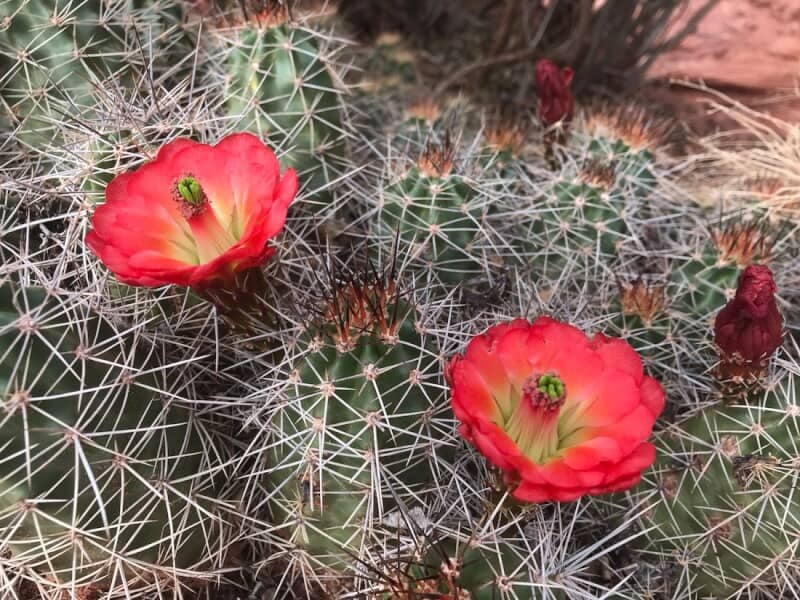
Scientifically named Echinocereus triglochidiatus, the Kingcup cactus is a type of cactus native to the southwestern United States and northern Mexico.
The most distinguishing feature of the cactus is its flowers. The flowers are scarlet red or orange-red, blooming in late spring.
The Kingcup cactus requires partial sunlight and a little bit of moisture. They grow best in well-draining porous soil.
13. Mexican Fence Post Cactus
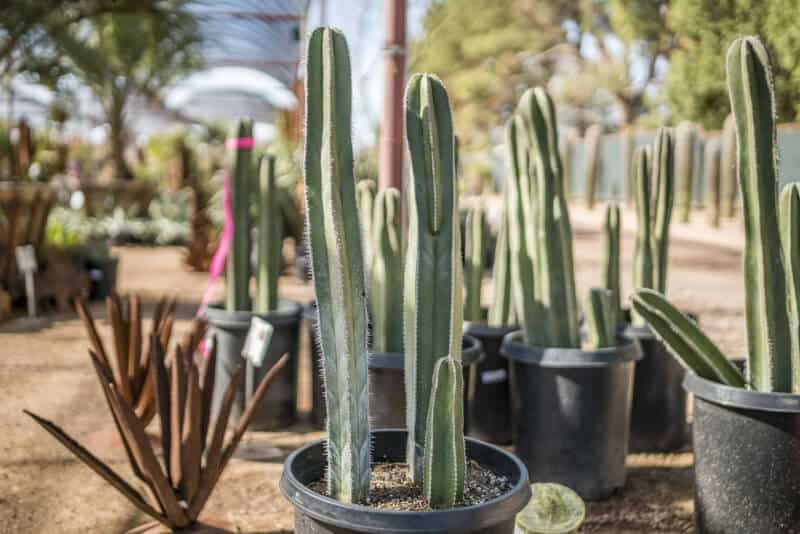
There are lots of cacti that get their name from their appearance. This one is different. It is named because of its “function”. That’s correct. Many Mexican use them as a fence, hence the name.
Scientifically known as Pachycereus marginatus, the Mexican Fence Post cactus is a slow-growing plant. As the plant matures up, they grow “arms”.
The height of a mature Mexican Fence Post cactus ranges from 3.7 to 6.1 m (about 12 to 20 feet), while the stems can grow to 9 to 10 cm (about 3 to 4 inches) in diameter.
Mexican Fence Post cactus is a flowering cactus, blooming in spring. The plant produces yellow and red fruits that contain black seeds.
For the best growth, plant Mexican Fence Post cactus in porous soil and place them where they can get both full sunlight and partial shade. As for watering, water the plant occasionally during the dry, hot months.
14. Old Man Cactus

Previously we talked about the Old Lady Cactus. This one here is the Old Man. As funny as it sounds, this cactus is real. Cephalocereus senili, or the Old Man cactus, is a native to eastern Mexico.
The Old Man is a columnar species of cactus. Its stems, which come in clusters, can grow to 5 to 15 meters in height.
The most distinguishing and striking feature of the cactus is its white hair and shaggy coat, which, upon seeing, you’d think of the unkempt hair of an old man. Yes, that was where the name came from.
The Old Man cactus loves well-draining soil and grows well in Mediterranean climates. They love heat and bright light, so choose the planting spot accordingly.
You don’t need to water the plant often. Just water the plant thoroughly when the soil is dry.
15. Organ Pipe Cactus

Next is Stenocereus thurberi or the Organ Pipe cactus. This type of cactus is native to Mexico and the United States.
The cactus has a few stems which are 15 cm or 6 inches thick. The average height of these stems is 4.9 meters or 16 feet. Some others can even grow as tall as 23 to 26 feet.
For the best growth, plant the Organ Pipe cactus in well-drained and gritty soil. Organ Pipe cacti are mostly found in rocky deserts, so access to full sunlight is recommended.
Organ Pipe cacti have a lifespan of 150 years.
When it comes to watering, water as needed. You can water the plant regularly in early spring. Like with most other types of cactus on the list, avoid overwatering.
16. Peanut Cactus
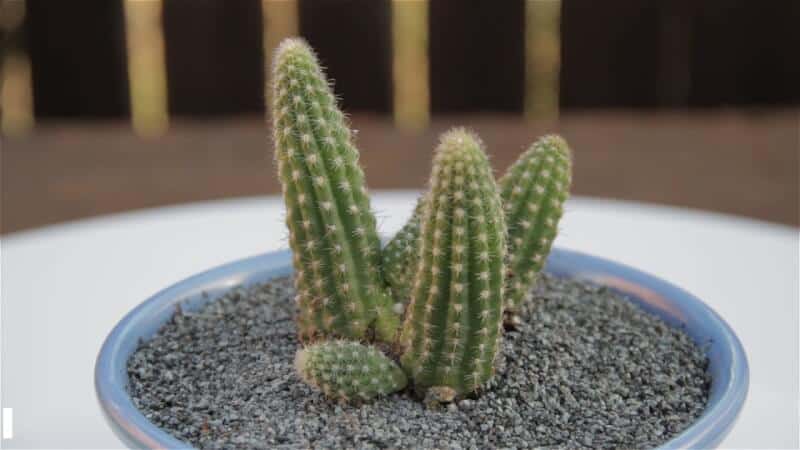
If you’re looking for a cactus that can be grown both outdoors and indoors, Echinopsis chamaecereus, better known as the Peanut cactus, is a good choice.
Native to Argentina, this cactus loves sunlight so it is best to plant them where they can get as much sunlight as possible.
The Peanut cactus has long stems which are 1 cm or 0.4 inches wide. The plant is quite small, only reaching up to 15 cm or 6 inches in height
The Peanut cactus is a flowering cactus. They produce 4 cm or 6 inches wide orange flowers in late spring.
This cactus is susceptible to rot. So be very careful when it comes to watering. Water the plant only when the few inches surface of the soil is very dry. If the surface is still wet, don’t water them
17. Prickly Pear Cactus
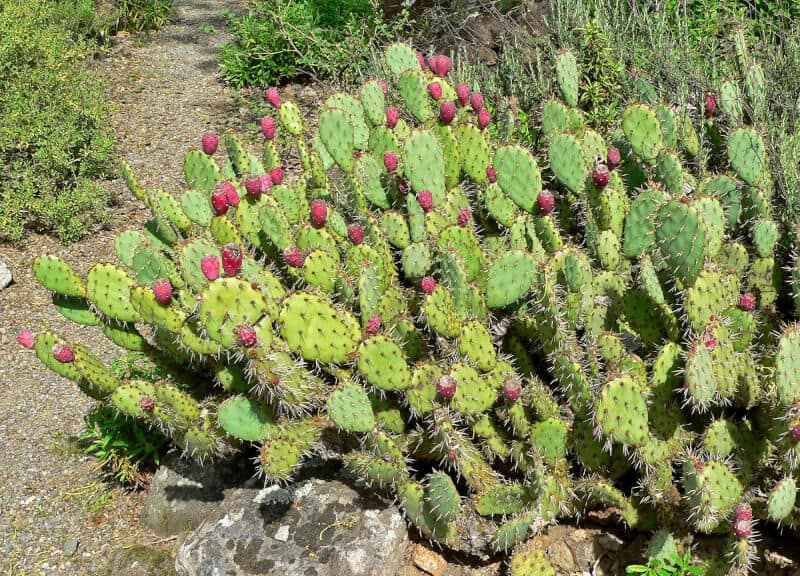
The Prickly Pear Cactus is a type of cactus native to the Americas. The cactus produces prickly pears or fruits called Tuna.
This cactus can grow to 5 to 7 meters or 16 to 23 feet high. The spines can grow to 2.5 centimeters although there are some Prickly Pear Cacti that are spineless.
The fruit of the cactus is a delicacy in Mexico. The colors of the fruits vary from green, wine-red, yellow-orange, to red. Depending on their ripeness, these fruits can be eaten raw.
The pads, called Nopals, are also edible. They have been used in various Mexican dishes like salads and eggs.
Prickly Pear Cacti require ample sunlight to grow well, so be sure to find a good spot for them. As for watering, you can water the plant once every two to four weeks.
This type of cactus requires no pruning. Well-draining porous soil is recommended for best growth.
18. Queen of Night Cactus

Epiphyllum oxypetalum, often referred to as the Queen of the Night cactus, is undoubtedly among the most beautiful cacti.
Native to Southern Mexico, the Queen of the Night cactus is a fast-growing plant. They flower from late spring to the entirety of summer.
The cactus has two types of stems. The first ones are the primary stems which can reach 6 meters in length. The second ones are flat, smaller stems, growing to 30 cm by 10-12 cm.
If you’re looking forward to seeing the flowers, keep in mind that the flowers bloom at night. They then wilt just before dawn, so having a reminder would be very helpful.
The flowers of the Queen of the Night tend to have a sweet scent and white color. The cactus also produces purple-red fruits.
Although this cactus grows well outdoors, it is best to keep them under a shade. As for watering, water when necessary.
19. Silver Torch Cactus
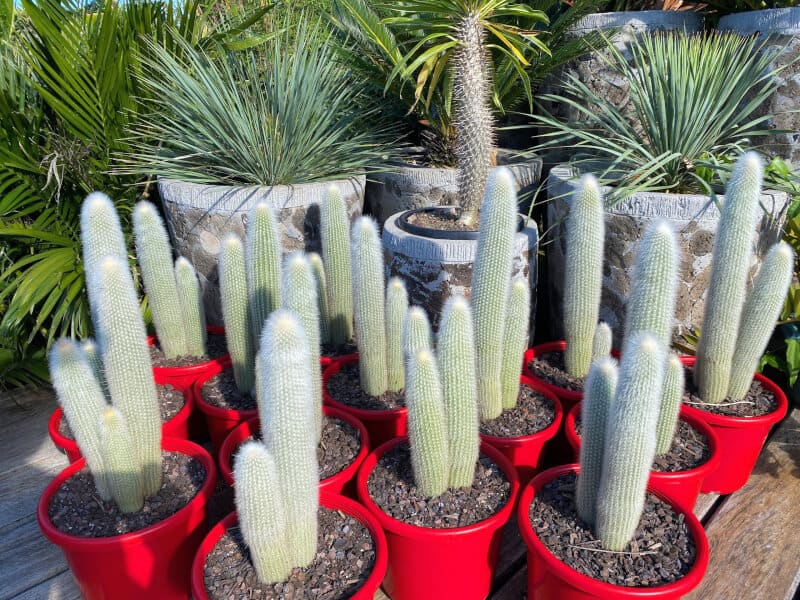
Have you ever seen a cactus plant that looks like a snow pole? If you haven’t, check out the Silver Torch Cactus.
Scientifically known as Cleistocacus strausii, the Silver Torch Cactus has a very unique appearance. The cactus is native to the mountain regions in Bolivia and Argentina.
The cactus can grow to up to 3 meters or 9.8 feet and has slender and erect green or grey columns that grow 6 cm or 2.5 inches across.
It is a flowering cactus. The cactus produces burgundy and deep red flowers in summers.
The best soil for the Silver Torch Cactus is a highly-draining one. The plant loves sunlight. Do keep in mind, however. While full sunlight is needed, high temperatures are not.
The Silver Torch Cactus needs lots of water during summer but during winter, they need none at all.
20. Totem Pole Cactus
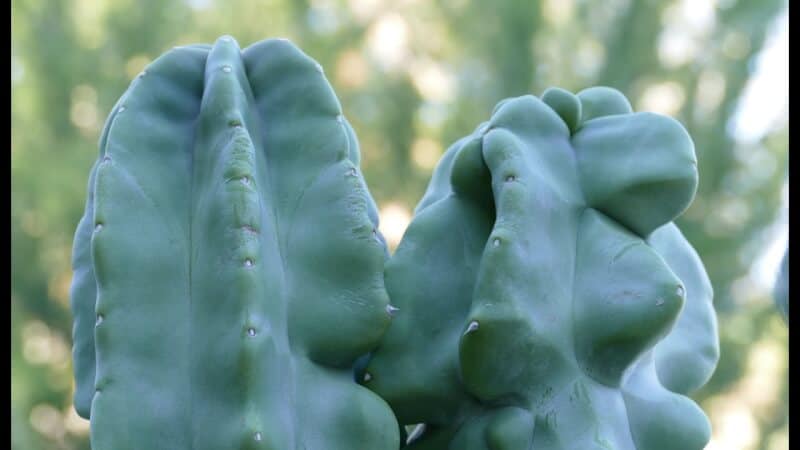
While most types of cactus on the list have visible spines, this one doesn’t. Rather, the Totem Pole cactus is smooth-skinned.
Scientifically known as Pachycereus schottii f. Monstrosus, this plant can reach 3.6 meters or 12 feet in height. It has numerous small bumps, which makes the cactus appear as if it is carved.
The Totem Pole cactus is a flowering cactus, blooming light pink flowers that open in the evening and close in the morning. The plant produces edible fruits that have an egg-like shape.
This cactus is low maintenance. Practically speaking, even if they are uncared for, they can even grow on their own. Of course, for optimal growth, you must take care of them.
The Totem Pole cactus grows well under a partial shade. It doesn’t demand much when it comes to watering. Water the cactus only when it is needed.
Tips for Choosing the Right Cactus Plant
Now you know there are plenty of types of cactus. Which one is the right one for you? Unfortunately, we can’t answer that directly for you.
Instead of giving you the answer, we will give you some tips to help you find the right cactus for you.
1. Hard or soft water

First thing first, the water. What kind of water do you have? Let’s say that you’re using hard water. In that case, you will need to get a decalcifier.
If you’re not using a decalcifier, it will lead to an iron deficiency for the plant. Why? Because hard water contains calcium, which blocks iron, thus leading to an iron deficiency.
If you’re using soft water, then there is nothing to worry about.
2. When shopping for a cactus, check its outer appearance
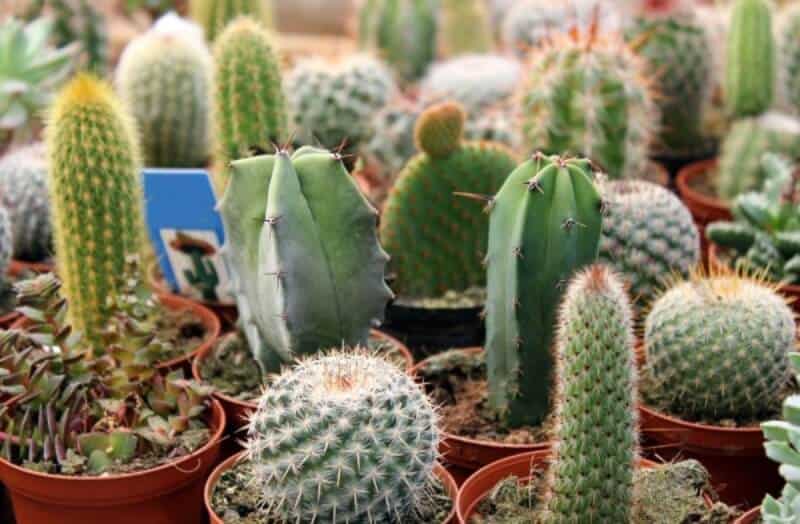
Don’t pick the first cactus you see. Check the appearance of the cactus first, particularly the trunk and spikes.
The trunk of a cactus should be firm to touch and robust. During fall or winter, the trunk of a cactus might be a bit wrinkly. This is normal so it shouldn’t be a problem.
As for the spikes, a healthy cactus will have dense spikes with good color.
3. Do not choose a cactus that shows signs of poor care or sickness
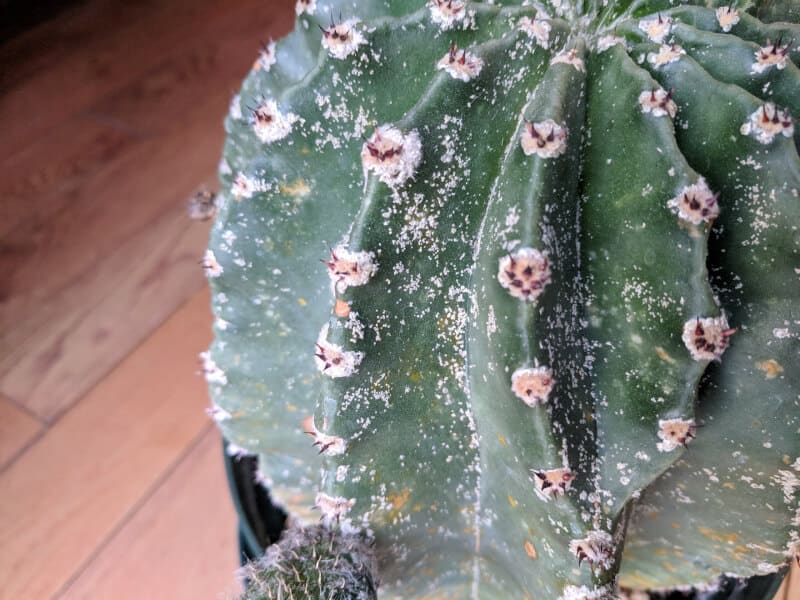
You want a healthy cactus. Never choose one that shows signs of poor care or sickness. Fortunately, this is an easy thing to do. Bruising or spots are easy to see. So is another sign like a weak pale trunk.
4. A cactus with a decorative fake flower attached should be avoided

There are two reasons why. Firstly, a decorative fake flower looks bad in the first place. A natural flower is much superior to a fake one.
Secondly, such a decoration makes it easier for infectious diseases to enter the cactus.
If, however, you decide to buy a cactus with a decorative fake flower, remove the flower. This will leave behind a small wound on the cactus. Don’t worry. This wound will heal quickly.
Speaking of flowers, whatever the types of cactus are, they take time to bloom. Using fake flowers is nothing more than a selling ploy.
5. Where do you want to keep it? Indoors or outdoors?
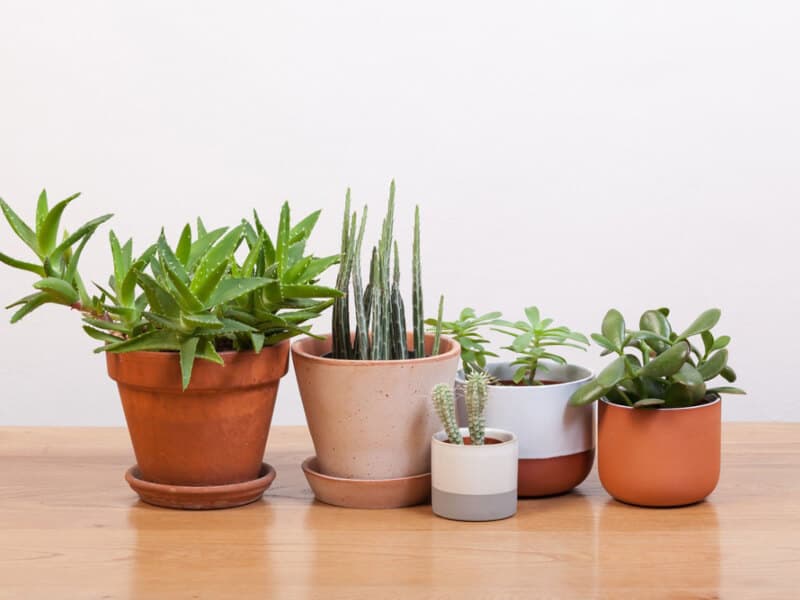
This is very important. Where do you want to keep the cactus? You need to decide this before shopping for cactus. Deciding indoors or outdoors will help you find the cactus with the right size.
Now that you know the types of cactus that best grow indoors and outdoors, this should not be a problem for you.
6. Consider the container or pot

The container or pot is important, especially if you’re planting indoors. It is about retaining water. A cactus planted outdoors retains water more as the plant grows directly on the ground.
A cactus planted indoors, on the other hand, needs assistance to retain water. The best container or pots for indoors cacti are the ones made from plastic or ceramic.
These kinds of containers or pots help to retain a lot of water. Don’t go for containers or pots made of clay as water will evaporate more easily in them.
7. Don’t buy based on price only
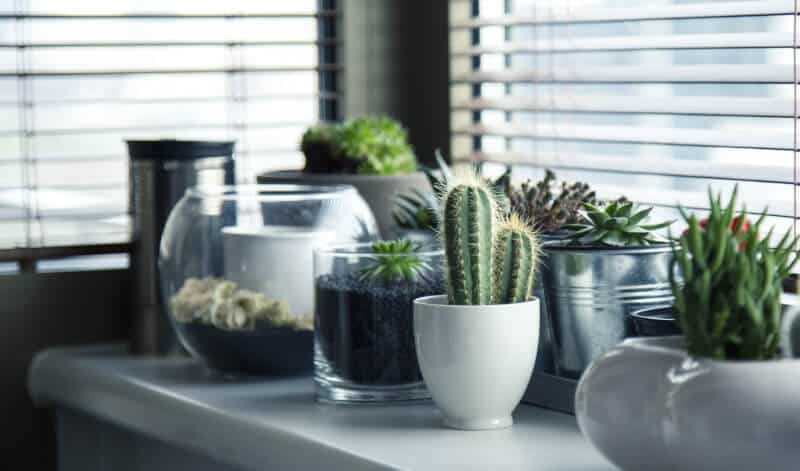
Whatever we buy, including a cactus, price is an important factor to consider. That being said, it should never be the only deciding factor.
Why? Because price does mean a difference in the condition and quality of the cactus. A cheaper cactus might not have as good condition and quality as the more expensive one.
8. Just starting? Start with a low-maintenance type
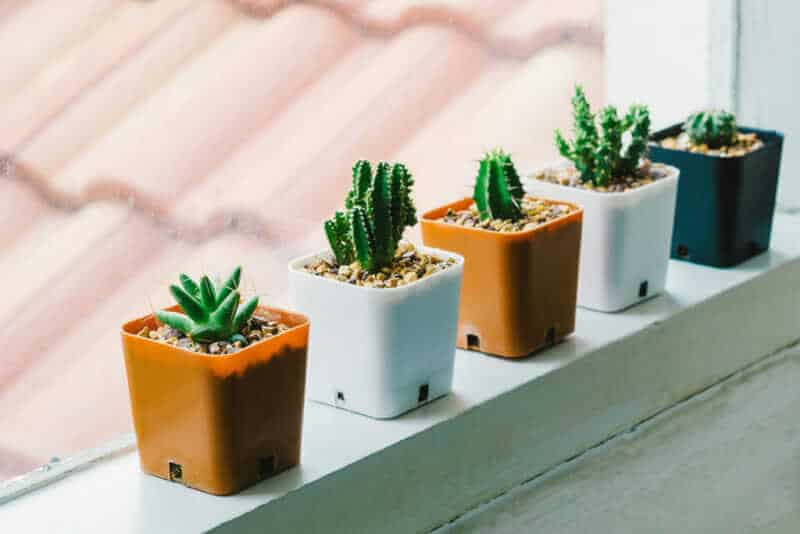
There are plenty of types of cactus. For beginners, it is best to start with types that grow easily and low maintenance.
9. If you shop online, check the estimated shipping time

This is for the cactus’ sake. You don’t want any delay in the shipping when you buy a cactus online.
10. The best way to buy a cactus

Online shopping surely is nice and convenient. But the best way to buy a cactus is to buy it from a store. When you buy a cactus from a store, you can check the conditions and qualities of the plant in person.
Tips to Grow a Cactus
1. Observe
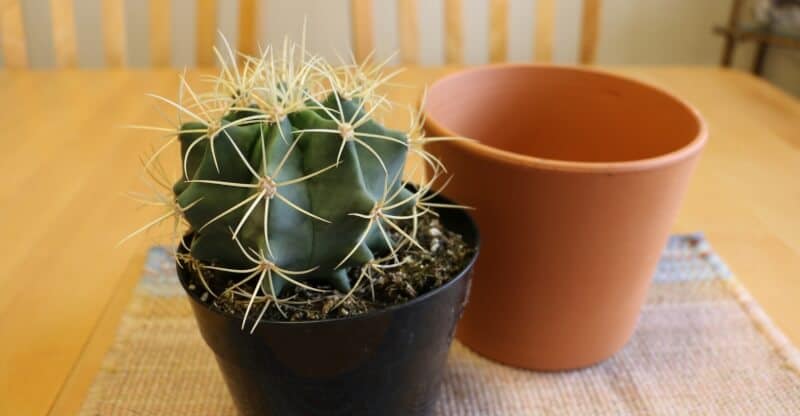
Observing your cactus is very important. When you observe your plant, you can find any potential issue becomes they become a problem and solve it immediately.
2. Potting mix
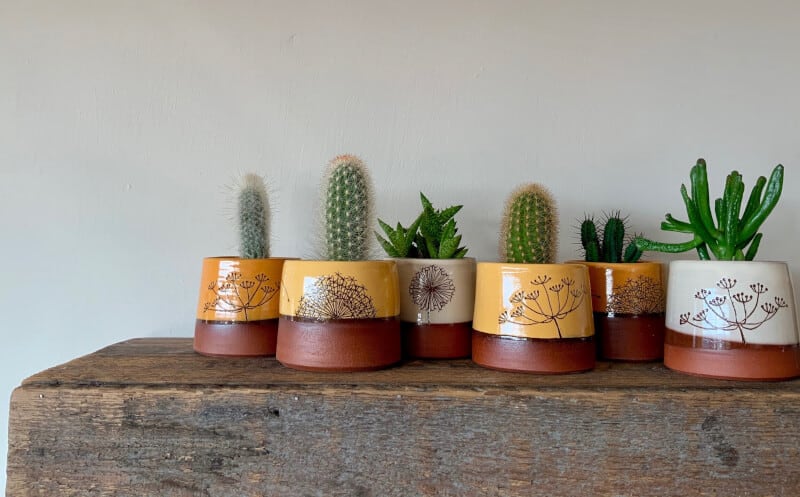
The living conditions of cacti vary differently from one species to another. There are cacti that grow well in dry sandy soils, there are others that do well in rainforests, and so on.
This is why there is no potting mix that suits every cactus. When you decide to plant a cactus, do simple research about the species and its living conditions.
After that, get a potting mix that is as similar as possible to the cactus’ natural living conditions.
3. Watering

Like any other plants, cacti need watering. The question, how frequently should you water a cactus? Just as the potting mix, there is no single solution to this. One thing is certain: a watering schedule is necessary.
Most types of cactus grow during the warmer seasons. At this time, they need to be watered adequately. During cold seasons, however, they don’t need as much watering, if any.
On average, during spring or summer, you can water a cactus on weekly basis or more, depending on whether the soil has dried or not.
The watering requirements also depend on the placement of the cactus. A cactus that is placed under direct sunlight will need more watering compared to one that is placed under a shade.
Both overwatering and underwatering must always be avoided. The former makes the roots of the cactus rot while the latter makes the cactus pale and bends. You want neither of these.
Balance is very important here.
4. Fertilizer

Nutrients are necessary for a plant to grow healthy and well. This, of course, applies to cacti as well. Fortunately, fertilizers designed for cacti are widely available.
For most cactus plants, the growing season is in the warmer months. It is at this time that fertilizer is necessary.
When looking for fertilizer, make sure to get one that has high phosphorus but low nitrogen contents. This kind of fertilizer will help to maintain the cactus’ healthy look.
If you potted or repotted a cactus recently, don’t use fertilizer until it has established itself in the new pot. This process can take as long as two months.
5. Sunlight

Next is sunlight. This, again, varies depending on the types of cactus. For example, desert cacti like direct sunlight. The tropical cacti, on the other hand, prefer partial shade.
What about indoor cacti? To ensure they get enough light, place them about 4 feet from a window facing south or east. Rotate the cactus every month or so. Too much sunlight will turn them white or yellow.
What if you can’t provide enough sunlight for a cactus? In that case, you can use grow lights as substitutes.
6. Pests
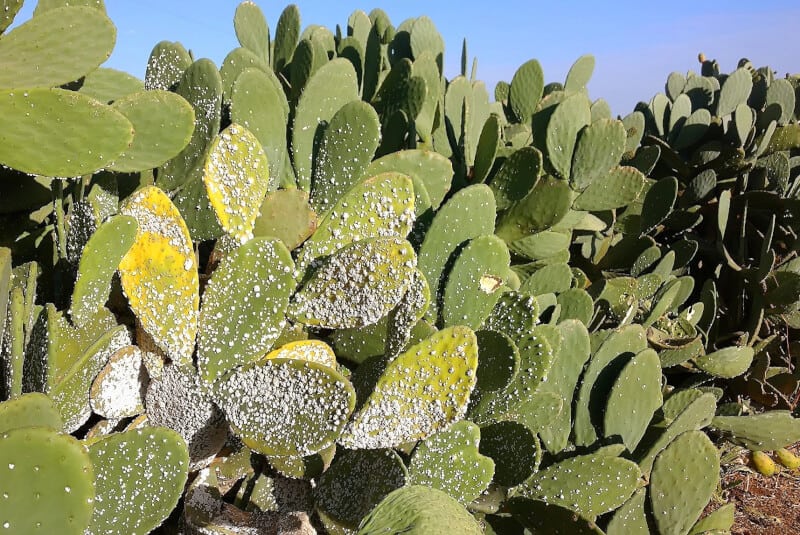
When it comes to pests, cacti don’t need as much case as other plants. Pests are seldom a problem for cacti, after all. That being said, once in a while, they might cause a problem.
To manage pests, practice measures to prevent pests. For example, keep the cactus as healthy as possible. That means ensuring the plant gets enough sunlight, water, and has proper drainage.
If a cactus thrives, it is less likely to suffer from pest attacks. Also, keep the pots clean from any dead leaves which might attract pests.
In case you find any pests on your cactus, you can use insecticidal soap to get rid of them. Do keep in mind that the soap can damage cacti. So, be sure that the soap is safe to use for cacti before applying.
7. Repotting
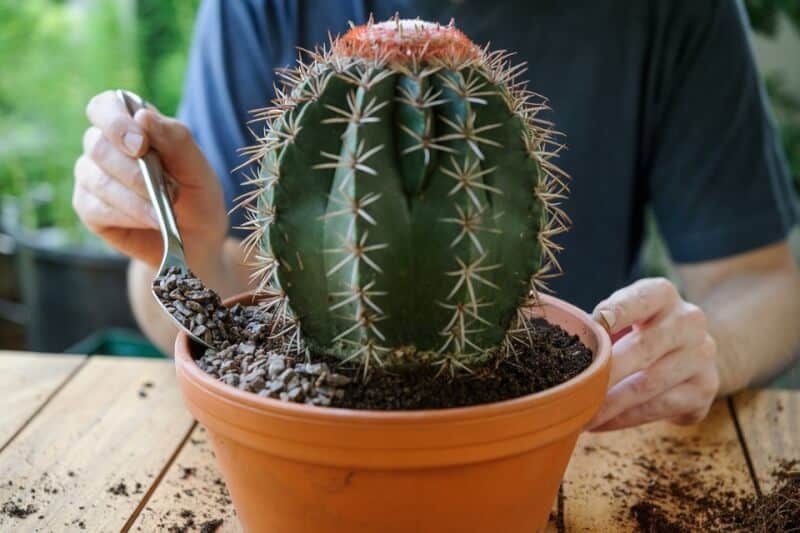
When you notice that your cactus’ roots grow outside the pot, it is time to repot the plant. It is recommended to repot a cactus once every 2 to 4 years.
When you repot a cactus, make sure to use the necessary tools to ensure both your and your plant’s safety.
Cactus FAQs
Curious about cactus? These frequently asked questions might have the answer to your questions.
1. What is inside of a cactus?
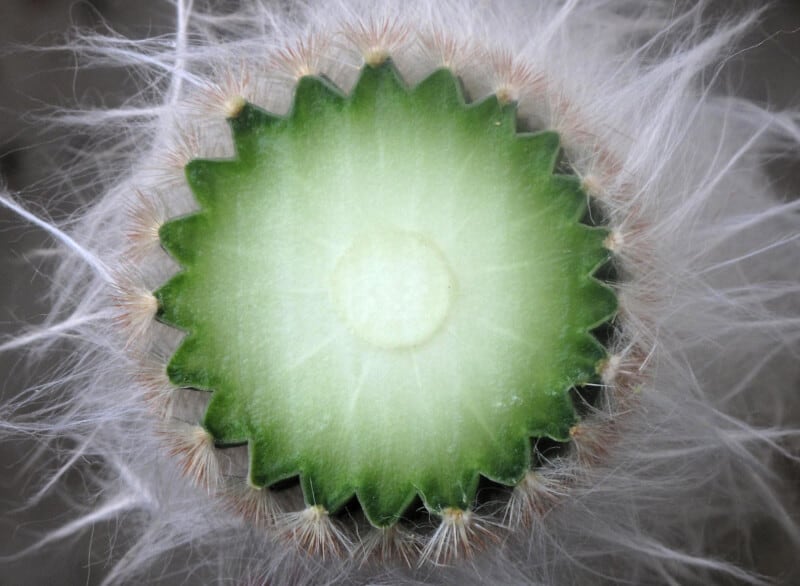
A cactus has a succulent stem that is dense and tough-walled. This succulent stem can retain water inside the stem. Both of these stems are green, fleshy, and photosynthetic.
Depending on the cactus, the inside of the stems is somewhat solid or spongy. A thick and waxy coating inside the cactus prevents the water from evaporating.
2. Why do cacti have spines?
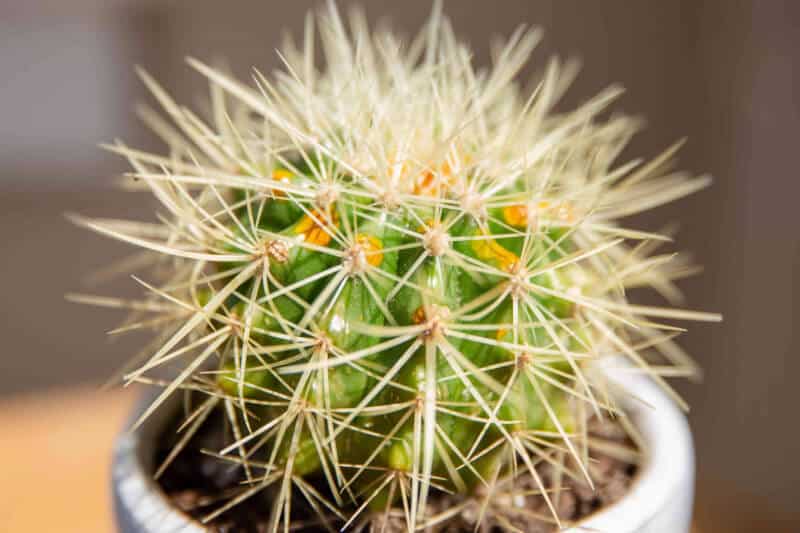
This is probably one of the most frequently asked questions about cactus. Why do these plants have spines?
Cacti have spots known as insoles, from which spines grow. In a sense, spins can be regarded as modified leaves. Spines shield the plant from predators, although spines don’t always make a cactus safe.
3. Are cacti succulents?
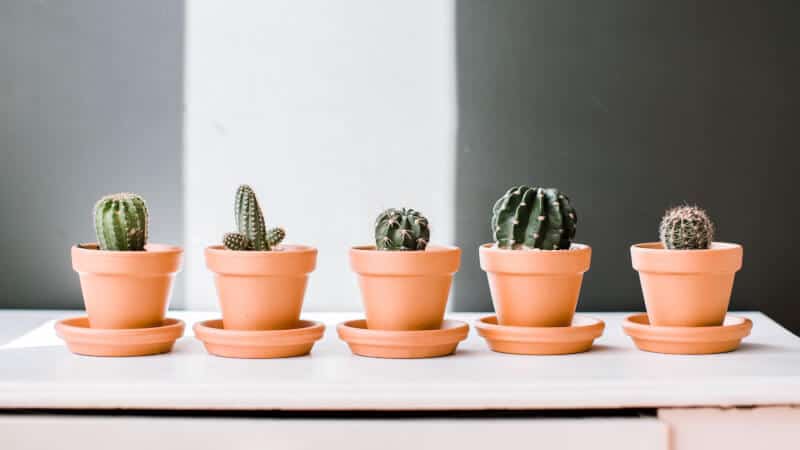
Short answer: yes. Yes, they are. Keep in mind, however, while each and every cactus is a succulent, not all succulents are cactus.
Cacti retain water easily. These plants store water throughout their fleshy part. What makes cacti different from other succulents is that they contain isolates.
Isolates are the areas from which cacti’s spines grow. Most of the other succulents don’t have this, allowing cacti to stand out from them.
4. Are cacti trees?

No, but there is no denying that they do resemble trees in many ways. Despite these resemblances, cacti are not considered as trees. Those that look very similar to trees are called treelike.
Some cacti have characteristics that trees have. For example, bark, leaves, and the ability to grow into treelike forms.
In short, cactus plants are considered as a part of Cactaceae. They are not trees.
5. Are cacti flowers?
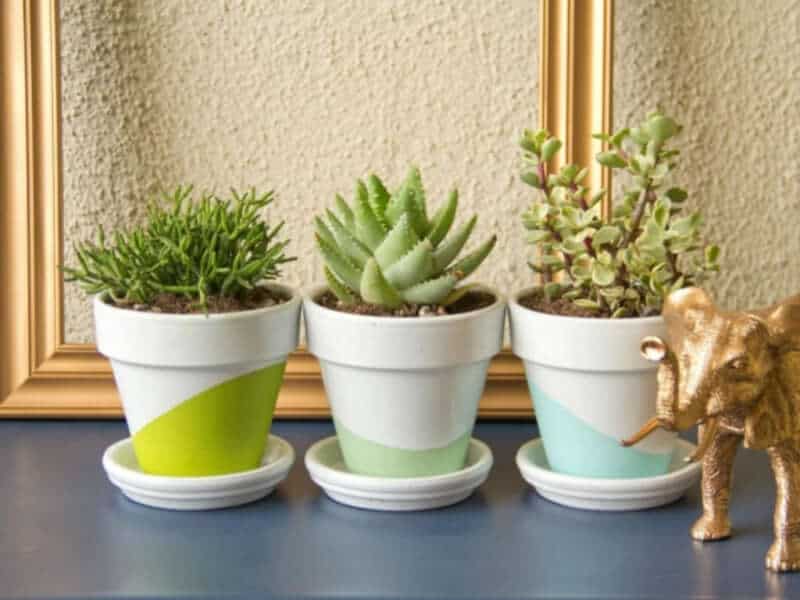
Most cacti are not considered as flowers. That said, some species of cactus are recognized to have flowers that grow out of them.
For example, varieties such as Echinopsis produces beautiful flowers, causing many people to assume that cacti are flowers.
For the most part, cacti are the host for flowers. This is why cacti are always considered as plants. Some cacti only grow spines and no flowers at all, so the term flowers don’t apply to them.
6. Can cacti grow indoors?
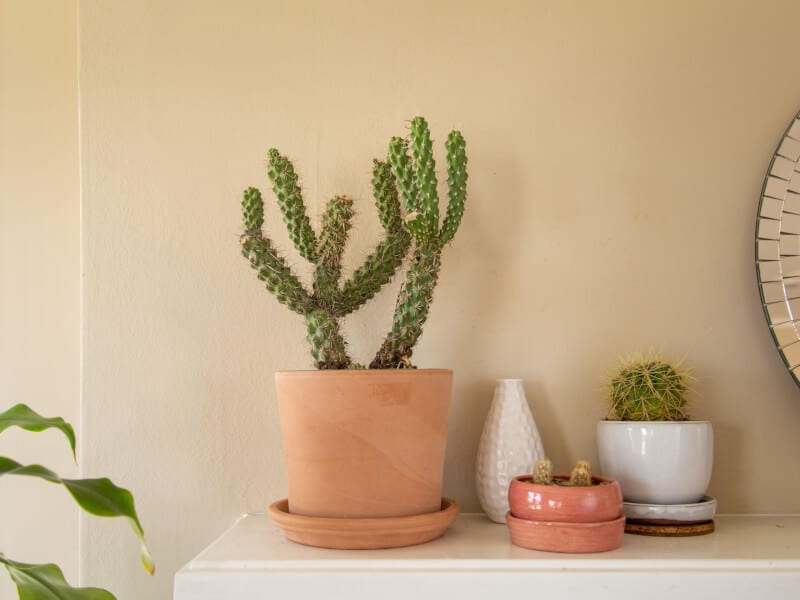
The answer is, of course, yes. Cacti can grow indoors. What is important to note is that for the cactus to grow well, they need a similar atmosphere to that of their natural habitat.
In general, that means placing the cactus where it can get enough sun.
The soil in which the plant grows also matter. It is recommended to use different soil to provide a similar setting like the natural habitat of the cactus. For example, combining sand and water.
7. Can cacti grow in a container or pot?

Of course they can. Cacti come in various shapes and sizes. There are plenty of types of cactus that can grow in a container or pot.
In fact, cacti that can grow in a container or pot are among the most popular types for people who want to breed cactus.
These cacti are very convenient to take home. They can be a decoration in the house, apartment, or garden too. Best of all, they are low-maintenance plants and very easy to take care of.
8. Can cacti grow in average soil?
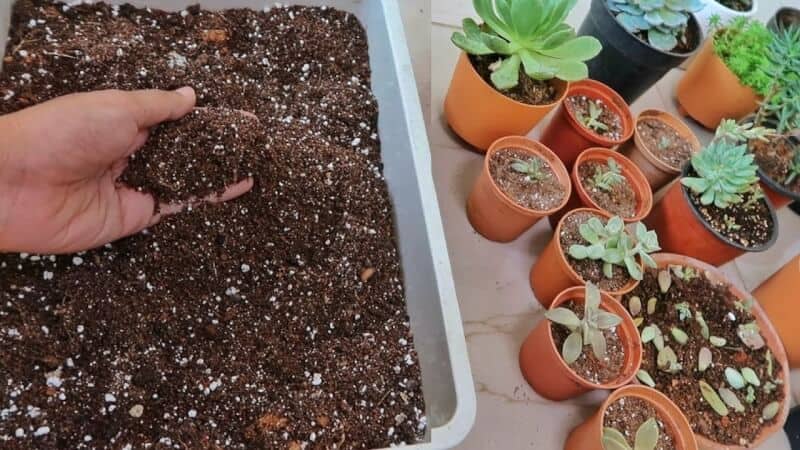
Yes, they can. They wouldn’t grow healthy and well, however. Average soil does not provide the optimal condition for a cactus to grow healthy and well.
Fortunately, cacti potting soil are widely available. Planting a cactus couldn’t be easier, thanks to that.
9. Can cacti grow in sand?

Most wild cactus plants grow in a mixture of soil and sand but yes, they can grow in sand. Cacti can grow in sand or around sand. Why? Because sand is a vital part of the environmental makeup of cacti’s habitats.
There are various types of cactus, each with its own unique characteristics. From flowering cacti, cacti that can grow very tall, to cacti that bloom every Christmas or Easter. So, which one is your favorite type?
